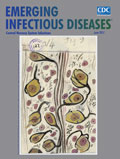
Volume 23, Number 6—June 2017
Research Letter
PCR Detection of Mimivirus
On This Page
Abstract
In an epidemiological study, mimivirus was reported as an unlikely cause of human respiratory infections in China. Our analysis revealed the nonsensitivity of the PCR method, which detected less than 10% of the current known mimivirus. We conclude that epidemiologic studies must use accurate and sensitive laboratory test methods.
The article by Zhang et al. (1) reporting the failure to detect mimivirus (Acanthamoeba polyphaga mimivirus) in patients with acute respiratory symptoms was flawed in 2 ways. First, a single mimivirus was detected by PCR but was dismissed by the authors as colonization. Second, and of greater concern, the PCR used by the authors would not detect most known mimiviruses because of primer/probe mismatches. In fact, PCRs used in most mimivirus prevalence studies would fail to detect most mimiviruses, given the extensive genome sequence diversity of these viruses (2).
We evaluated the PCR primers/probes used by Zhang et al. (1) for sequence similarity with 51 mimivirus genomes available in the public domain since March 2016, the date on which the article by Zhang et al. was submitted (3). Our in silico analysis found that none of the 25 genomes available from lineage A and 7 genomes from lineage B were complementary with their primers and probes, and only 5 of 19 lineage C genomes showed sufficient sequence similarity to permit successful amplification (Table). Overall, the PCR used by these authors would be predicted to detect only ≈26% of lineage C mimiviruses and <10% of published mimivirus genomes overall.
As proposed by Ngounga et al. (4), the great variability across the 3 lineages of mimivirus genomes requires the design of lineage-specific primers to improve PCR sensitivity (4). Until PCRs are improved, mimiviruses might be best detected by metagenomic approaches that have recently seen success in terms of mimivirus detection. For example, mimivirus-like reads have been identified by metagenomics in 1 (8%) of 12 fecal samples from children with acute diarrhea (5); 5 (27%) of 18 prostatic secretion samples from persons with prostatitis (6); all DNA libraries tested from the plasma of patients with hepatitis (7); 0.0018% of total viral reads from nasopharyngeal samples from 210 patients with respiratory tract symptoms (8); and all tested fecal, mid-vaginal, buccal mucosal, and retroauricular crease samples, with a predominance of miniviruses in fecal samples reaching ≈33% of the total viral reads (9).
In metagenomics approaches, the number of reads detected and the distribution along the whole viral genome are essential parameters for viral detection. In practice, the search for mimivirus is complicated by the great genetic variability of the virus and the restricted availability of mimivirus culture systems to a few research laboratories (10). The deficiencies we found in the report by Zhang et al. highlight the need for carefully designed epidemiologic studies using sensitive laboratory test methods to accurately assess mimivirus prevalence and the potential role of mimivirus in human disease.
Dr. Raoult is an Associate Editor of Emerging Infectious Diseases and a professor of microbiology at the School of Medicine, Aix-Marseille University, Marseille, France, and is head of the University Hospital Institute Méditerranée Infection in Marseille.
References
- Zhang XA, Zhu T, Zhang PH, Li H, Li Y, Liu EM, et al. Lack of mimivirus detection in patients with respiratory disease, China. Emerg Infect Dis. 2016;22:2011–2. DOIPubMed
- Colson P, Aherfi S, La Scola B, Raoult D. The role of giant viruses of amoebas in humans. Curr Opin Microbiol. 2016;31:199–208. DOIPubMed
- Levasseur A, Bekliz M, Chabrière E, Pontarotti P, La Scola B, Raoult D. MIMIVIRE is a defence system in mimivirus that confers resistance to virophage. Nature. 2016;531:249–52. DOIPubMed
- Ngounga T, Pagnier I, Reteno DG, Raoult D, La Scola B, Colson P. Real-time PCR systems targeting giant viruses of amoebae and their virophages.Intervirology. 2013;56:413–23. DOIPubMed
- Finkbeiner SR, Allred AF, Tarr PI, Klein EJ, Kirkwood CD, Wang D. Metagenomic analysis of human diarrhea: viral detection and discovery. PLoS Pathog. 2008;4:e1000011. DOIPubMed
- Smelov V, Bzhalava D, Arroyo Mühr LS, Eklund C, Komyakov B, Gorelov A, et al. Detection of DNA viruses in prostate cancer. Sci Rep. 2016;6:25235. DOIPubMed
- Law J, Jovel J, Patterson J, Ford G, O’keefe S, Wang W, et al. Identification of hepatotropic viruses from plasma using deep sequencing: a next generation diagnostic tool. PLoS One. 2013;8:e60595. DOIPubMed
- Lysholm F, Wetterbom A, Lindau C, Darban H, Bjerkner A, Fahlander K, et al. Characterization of the viral microbiome in patients with severe lower respiratory tract infections, using metagenomic sequencing. PLoS One. 2012;7:e30875. DOIPubMed
- Rampelli S, Soverini M, Turroni S, Quercia S, Biagi E, Brigidi P, et al. ViromeScan: a new tool for metagenomic viral community profiling. BMC Genomics. 2016;17:165. DOIPubMed
- Saadi H, Pagnier I, Colson P, Cherif JK, Beji M, Boughalmi M, et al. First isolation of Mimivirus in a patient with pneumonia. Clin Infect Dis. 2013;57:e127–34. DOIPubMed






















.png)











No hay comentarios:
Publicar un comentario